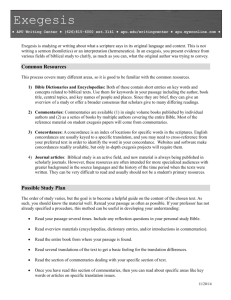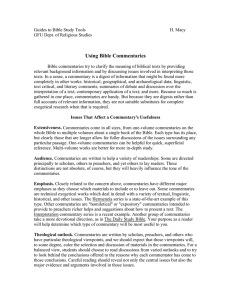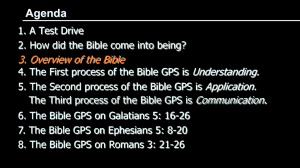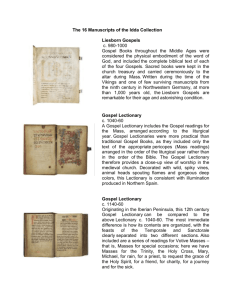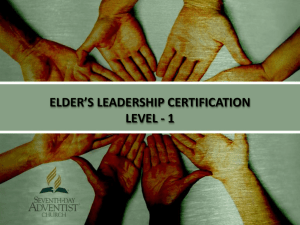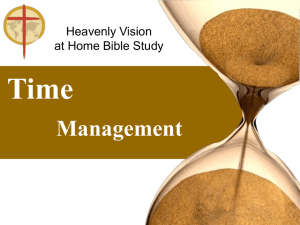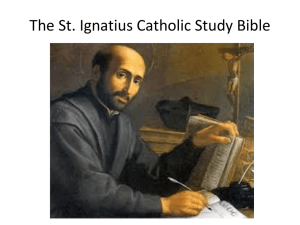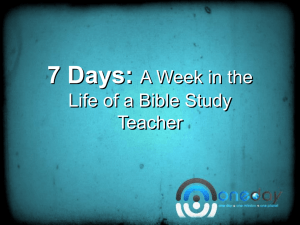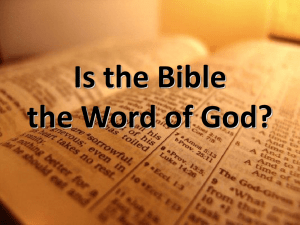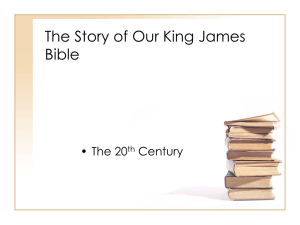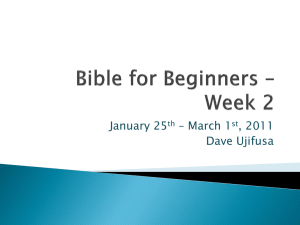Torah Commentators
advertisement
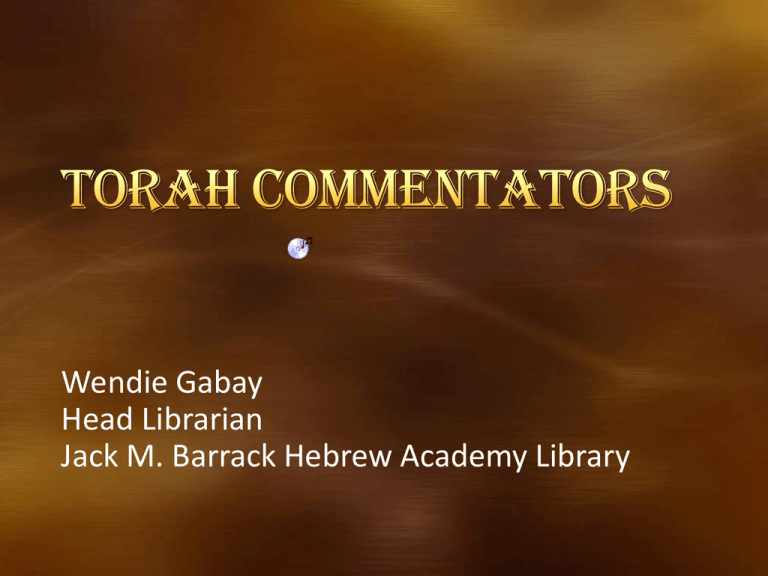
Wendie Gabay Head Librarian Jack M. Barrack Hebrew Academy Library French Philosopher ( 1288 - 1344 ) Commonly known as GERSONIDES. Philosopher, mathematician, astronomer, and Bible commentator, who practiced medicine. The RALBAG wrote commentaries on Job (1325), Song of Songs (1325 or 1326), Ecclesiastes (1328), Ruth (1329), Esther (1329), the Pentateuch (1329– 38), the Former Prophets (1338), Proverbs, Daniel, Nehemiah, and Chronicles (1338). Diverse questions of a philosophical or theological nature are discussed by him, such as the problem of providence, miracles, and the Messiah. From each book of the Bible, Levi extracts the ethical, philosophical, and religious teachings that may be gleaned from the text and calls them to'alot or to'aliyyot. Born in Poland. First Jewish bibliographer. Assistant singer for the Altneu synagogue (Altneuschul) in Prague, hence, the nickname Bass. He published the Pentateuch with a super-commentary on Rashi, Siftei Ḥakhamim (1680), a popular commentary often reprinted; and Siftei Yeshenim (1680), His commentary is included in ( מקראות גדולותMikraot Gedolot) by Judaica Press U.S. Reform rabbi and author Plaut was born in Munster, Germany, and earned his law degree at the University of Berlin in 1934. When Nazi decrees made a law career impossible, he switched to Jewish studies. He was tutored by Abraham Joshua *Heschel His masterpiece remains The Torah – A Modern Commentary (1981), Rashi commented on most, if not all, the books of the Bible. The main distinguishing characteristic of Rashi's commentary is a compromise between the literal and the midrashic Interpretations. Rashi was born in Troyes, France. Ibn Ezra's commentary is devoted to precise and multifaceted linguistic clarifications, One of the most important Jewish Bible commentators; also a poet, composer of *piyyutim , grammarian, translator, philosopher, astronomer, and astrologer. He had a tendency to apply the rules developed by his predecessors with extreme caution and stringency. Born in Narbonne, France Author of a Hebrew grammar & dictionary (Mikhol & Sefer haShorashim) Kimhi used the methodology of Ibn Ezra and the elder Kimhis stressing scientific analysis. Kimḥi relied heavily on rabbinic literature. Kimḥi strove for clarity and readibility His commentary on the Prophets & the Psalms was translated from Hebrew into Latin, during the Renaissance period for the benefit of non-Jewish students of the Bible. Kimhi’s influence can be traced in every line of the King James Bible. He was strongly influenced by the rationalism of Ibn Ezra and Maimonides. He studied philosophy, mathematics, philology, and, in particular, medicine, He settled in Bologna, where he played an active role in resuscitating a Hebrew printing house and in organizing the community. He established a bet-midrash which he conducted until his death. His renown was such that Italian rabbis addressed halakhic questions to him. He focused on literary structure and vocabulary exegesis of the Bible. He was educated at the University of Florence, where he was ordained in 1908. A life-long Zionist, Cassuto accepted an invitation to fill the chair of Bible studies at the Hebrew University in 1939, where he taught until his death in 1951. Cassuto was appointed director of the Rabbinical Seminary in Florence, Italy. Born in Riga-Educated in Berlin From 1930, when she settled in Palestine, until 1955, she taught at the Mizrachi Women Teachers Seminary in Jerusalem. She was a regular Bible commentator on the Israel Broadcasting Service. From the late 1950s she taught Bible at Tel Aviv University (becoming a tenured professor in 1968) and at Bar-Ilan University. Leibowitz clearly understood that the layers of meaning in the Bible could only be taught if the student was an active player in the classroom. Her classes were not lectures but dialogues between herself, her students, and the written texts. Rabbi Moses Ben Naḥman; 1194–1270) E of Naḥmanides acted as chief rabbi Catalonia until his emigration to Ereẓ Israel. His commentaries are concerned mainly with the sequence of the biblical passages and with the deeper meaning of the Bible's laws and narrative. Spanish rabbi and scholar and one of the leading authors of talmudic literature in the Middle Ages; philosopher, kabbalist, biblical exegete, poet, and physician. Rabbi and Kabbalist Born in Salé, Morocco Desirous of establishing a college in Ereẓ Israel to which Diaspora students would flock in order to hasten the redemption, he set out for Ereẓ Israel together with his closest disciples, There he Established yeshivot. His best-known and most important work is the Or haḤayyim (Venice, 1742), a commentary on the Bible. Born is Lisbon, Portugal. Head of Treasury in Lisbon. Falsely accused of plotting against the court, he escaped to Castile, Spain. Abarbanel’s Bible writings were different from the usual biblical commentaries because he took social and political issues of the times into consideration. Following the Spainish Inquisition of 1492, found haven in Venice , Italy. There he completed literary works on philosophy, science, history and Torah commentaries. He also took the time to include an introduction concerning the character of each book he commented on, as well as its date of composition, and the intention of the original author, in order to make the works more accessible to the average reader. He treated the Bible as a living literature and a dynamic force Born in London, England in history, endowed with the Became a U.S. citizen in 1959. ability to move men and transform civilizations. World renowned lecturer and author in Biblical Studies. Librarian at Jewish Theological Sarna attempted to integrate Seminary. the results of a wide spectrum of research in many disciplines, and includes insights of generations of Jewish commentators. Wrote an easy to read commentary on Psalms, Proverbs, and Job. Began the popular Bible commentary Metsudath David מצודת דוד a lucid exposition of the biblical text and Metsudath Zion מצודת זיון a glossary explaining difficult words as they occur His son, Rabbi Yehiel Hillel Altschuler completed this work. His major work, the Arba'ah Turim, as a result of which he is commonly referred to as "the Ba'al ha-Turim. The work is divided into four sections (Turim, "rows”) Jacob also wrote a comprehensive commentary on the Torah (Zolkiew, 1806), containing the best expositions of the peshat ("literal meaning") by earlier Bible commentators, such as *Saadiah Gaon , *Rashi , Abraham *Ibn Ezra , David *Kimḥi , and others, in particular abstracting "the straightforward explanations" from the commentary of *Nahmanides and disregarding the kabbalistic ones. When Jacob added his own opinions it was usually to explain the reason for a Torah law or mitzvah.
